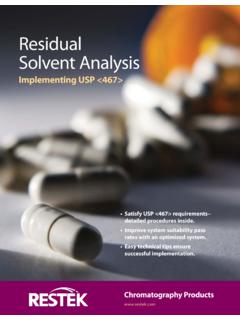Transcription of 9. How to Complete VA Form 26-6393, Loan Analysis,
1 VA Pamphlet 26-7, Revised Chapter 4: Credit Underwriting 9. How to Complete VA Form 26- 6393 , Loan Analysis, Continued c. Debts and List all known debts and obligations of the applicant and spouse including Obligations any alimony and/or child support payments. Place a check mark in the ( ) column next to any significant debt or obligation. See the topic Analysis of Debts and Obligations in section 5 of this chapter, for an explanation of significant.. Job Related Expense Include any costs for child care, significant commuting costs, and any other direct or incidental costs associated with the applicant's (or spouse's). employment. Check this item if total job-related expenses are significant. d. Item 33, Enter the applicant's estimated monthly Federal income tax. If the applicant Federal Income has a MCC, reduce the Federal income tax by the estimated tax credit. Tax Reference: See the topic Income Tax Credits from Mortgage Credit Certificates in section 3 of this chapter.
2 E. Item 44, Enter the appropriate residual income amount from the following tables in the Balance guideline box. residual income is the amount of net income remaining Available for (after deduction of debts and obligations and monthly shelter expenses) to Family Support cover family living expenses such as food, health care, clothing, and gasoline. The numbers are based on data supplied in the Consumer Expenditures Survey (CES) published by the Department of Labor's Bureau of Labor Statistics. They vary according to loan size, family size, and region of the country. Special Instructions for Using Tables Count all members of the household (without regard to the nature of the relationship) when determining family size, including: an applicant's spouse who is not joining in title or on the note, and any other individuals who depend on the applicant for support. For example, children from a spouse's prior marriage who are not the applicant's legal dependents.
3 Continued on next page 4-55. VA Pamphlet 26-7, Revised Chapter 4: Credit Underwriting 9. How to Complete VA Form 26- 6393 , Loan Analysis, Continued e. Item 44, Special Instructions for Using Tables (continued). Balance Exception: The lender may omit any individuals from family size who are Available for fully supported from a source of verified income which, for whatever reason, Family Support is not included in effective income in the loan analysis. For example: (continued). a spouse not obligated on the note who has stable and reliable income sufficient to support his or her living expenses, or a child for whom sufficient foster care payments or child support is received regularly. Reduce the residual income figure (from the following tables) by a minimum of five percent if: the applicant or spouse is an active-duty or retired serviceperson, and there is a clear indication that he or she will continue to receive the benefits resulting from use of military-based facilities located near the property.
4 Use five percent unless the VA office of jurisdiction has established a higher percentage, in which case, apply the specified percentage for that jurisdiction. A key to the geographic regions is listed in the following tables. Table of residual Incomes by Region For loan amounts of $79,999 and below Family Northeast Midwest South West Size 1 $390 $382 $382 $425. 2 $654 $641 $641 $713. 3 $788 $772 $772 $859. 4 $888 $868 $868 $967. 5 $921 $902 $902 $1,004. over 5 Add $75 for each additional member up to a family of seven. Continued on next page 4-56. VA Pamphlet 26-7, Revised Chapter 4: Credit Underwriting 9. How to Complete VA Form 26- 6393 , Loan Analysis, Continued e. Item 44, Balance Available for Family Support (continued). Table of residual Incomes by Region For loan amounts of $80,000 and above Family Northeast Midwest South West Size 1 $450 $441 $441 $491. 2 $755 $738 $738 $823. 3 $909 $889 $889 $990. 4 $1,025 $1,003 $1,003 $1,117.
5 5 $1062 $1,039 $1,039 $1,158. over 5 Add $80 for each additional member up to a family of seven Key to Geographic Regions Used in the Preceding Tables Northeast Connecticut New Hampshire Pennsylvania Maine New Jersey Rhode Island Massachusetts New York Vermont Midwest Illinois Michigan North Dakota Indiana Minnesota Ohio Iowa Missouri South Dakota Kansas Nebraska Wisconsin South Alabama Kentucky Puerto Rico Arkansas Louisiana South Carolina Delaware Maryland Tennessee District of Columbia Mississippi Texas Florida North Carolina Virginia Georgia Oklahoma West Virginia West Alaska Hawaii New Mexico Arizona Idaho Oregon California Montana Utah Colorado Nevada Washington Wyoming Continued on next page 4-57. VA Pamphlet 26-7, Revised Chapter 4: Credit Underwriting 9. How to Complete VA Form 26- 6393 , Loan Analysis, Continued f. Item 45, VA's debt-to-income ratio is a ratio of total monthly debt payments (housing Debt-to-Income expense, installment debts, and other debt) to gross monthly income.
6 Ratio Add: Items 15 + 16 + 17 + 18 +20 +40 = Debt Add: Items 31 + 38* = Income Divide: Debt Income = Debt-to-Income Ratio Round: To the nearest two digits The Debt-to-Income Ratio heading in section 10 of this chapter contains special procedures to apply if the ratio exceeds 41 percent. *Tax-free income may be grossed up for purposes of calculating the debt- to-income ratio only (not residual income). This is a tool that may be used to lower the debt ratio for veterans who clearly qualify for the loan. Grossing up involves adjusting the income upward to a pre-tax or gross income amount which, after deducting state and Federal income taxes, equals the tax- exempt income. Use current income tax withholding tables to determine an amount which can be prudently employed to adjust the borrower's actual income. Do not add non-taxable income to taxable income before grossing up.. Tax-free income includes certain military allowances, child support payments, workers' compensation benefits, disability retirement payments, and certain types of public assistance payments.
7 Verify that the income is indeed tax-free before grossing up.. If grossing up is used, indicate such and provide the grossed up ratio in item 47, Remarks.. g. Item 46, Past Indicate whether the applicant (and spouse, if applicable) is a satisfactory or Credit Record unsatisfactory credit risk based on a Complete analysis of credit data. 4-58. VA Pamphlet 26-7, Revised Chapter 4: Credit Underwriting 10. How to Analyze the Information on VA Form 26- 6393 . Change Date April 10, 2009, Change 10. This section has been updated to make minor grammatical edits. a. residual VA's minimum residual incomes (balance available for family support) are a Income guide. They should not automatically trigger approval or rejection of a loan. Instead, consider residual income in conjunction with all other credit factors. An obviously inadequate residual income alone can be a basis for disapproving a loan. If residual income is marginal, look to other indicators such as the applicant's credit history, and in particular, whether and how the applicant has previously handled similar housing expense.
8 Consider whether the purchase price of the property may affect family expense levels. For example, a family purchasing in a higher priced neighborhood may feel a need to incur higher-than-average expenses to support a lifestyle comparable to that in their environment, whereas a substantially lower priced home purchase may not compel such expenditures. Also consider the ages of the applicant's dependents in determining the adequacy of residual income. Continued on next page 4-59. VA Pamphlet 26-7, Revised Chapter 4: Credit Underwriting 10. How to Analyze the Information on VA Form 26- 6393 , Continued b. Debt-to- VA's debt-to-income ratio is a ratio of total monthly debt payments (housing Income Ratio expense, installment debts, and so on) to gross monthly income. It is a guide and, as an underwriting factor, it is secondary to the residual income. It should not automatically trigger approval or rejection of a loan. Instead, consider the ratio in conjunction with all other credit factors.
9 A ratio greater than 41 percent requires close scrutiny unless: the ratio is greater than 41 percent solely due to the existence of tax-free income (Put notation regarding the tax-free income in the loan file or calculate an adjusted, smaller ratio based on grossing up of the tax-free income.), or residual income exceeds the guideline by at least 20 percent. Loans Closed Automatically with Ratio Greater than 41 percent Include a statement justifying the reasons for approval, signed by the underwriter's supervisor, unless residual income exceeds the guideline by at least 20 percent. The statement must: not be perfunctory, or list the compensating factors justifying approval of the loan. c. Credit A poor credit history alone is a basis for disapproving a loan. History If credit history is marginal, look to other indicators such as residual income. Continued on next page 4-60.









![arXiv:1707.02921v1 [cs.CV] 10 Jul 2017](/cache/preview/a/1/f/6/e/b/6/7/thumb-a1f6eb6760e3138078c3c6131fc3f8e7.jpg)
